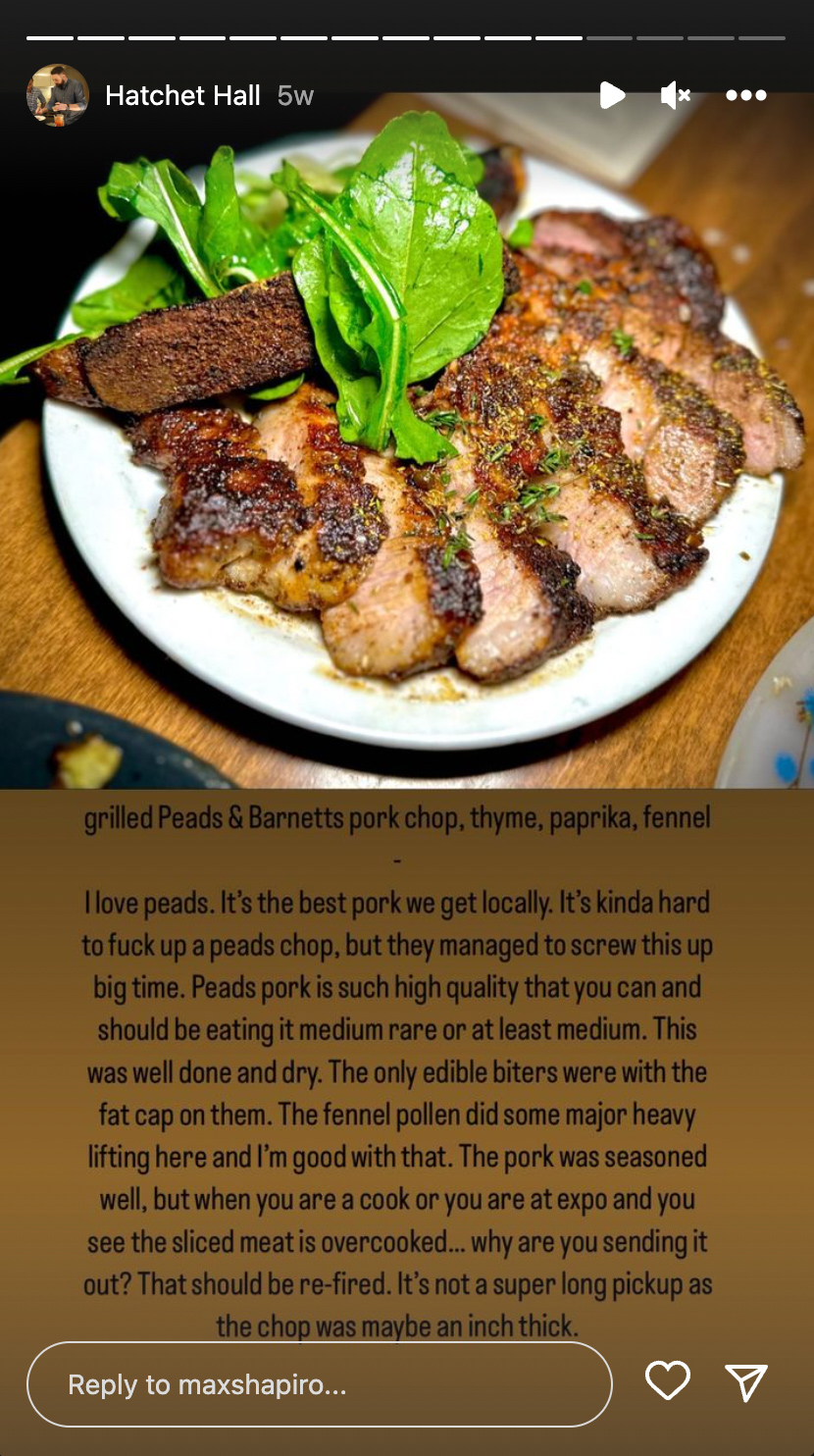Last December, when the Michelin Guide announced which California restaurants had been blessed with a coveted star (or stars) for the year—undoubtedly the most prestigious designation in the culinary world—new entrants such as chef Curtis Stone’s Gwen and 715, a spare, omakase sushi joint, garnered heartfelt applause at Michelin’s “Star Revelation” event held at Los Angeles’ Peterson Automotive Museum.
But not everyone was so bowled over by the selections made by the French tire company, which has been issuing its renowned restaurant guide for over a century now. “I think we all had a WTF moment when Hatchet Hall was called on to the stage to be awarded a star,” wrote Max Shapiro in a lengthy Instagram Story that he posted a week after the ceremony. The Story consisted of 15 artfully presented photos of a meal Shapiro had had at Hatchet Hall, a cozy, Southern-inspired eatery with city-famous cornbread.
Each slide diligently deconstructed appetizers, sides, and main courses with precise judgments worthy of a Top Chef episode. The dry-aged kanpachi crudo was deemed to have “a really good level of salt and acid” but condemned for having too much horseradish: “It completely blew out your nostrils and was all you could taste.” As for the grilled Peads & Barnetts pork chop: “It’s kinda hard to fuck up a peads chop, but they managed to screw this up big time.” The offense? The meat was well-done and dry. As for one of the dessert items, a single scoop of chocolate malt ice cream: “Tasted like Nesquik ice cream. The ice cream had a slightly powdery texture to it. Maybe from the malt powders? Not very good, unless you love Nesquik.”

Shapiro, a 39-year-old, 6 foot 2 Angeleno with a groomed hipster vibe, isn’t a credentialed restaurant critic or someone who has spent time as a restaurant sous chef or saucier (he was an unofficial one, he says, when he was 10). His main gig is selling luxury real estate, a career that took off 20 years ago when he was the go-to broker for such stars as Lindsay Lohan and Frankie Muniz. Shapiro is still hawking houses in Beverly Hills and Bel-Air, but his free time is spent on a kind of non-stop fine-dining tour of L.A.—and the world—a pastime he’s been pursuing since he was a kid growing up in L.A. (Family dinners were often at Mr. Chow).

Shapiro’s love of food and the dining experience—combined with his fearlessness, curmudgeonly wit, and understanding of the elements of what makes both a successful dish and an inviting vibe—make his reviews a refreshing antidote to what passes for restaurant criticism these days. The internet—and Instagram in particular—is awash in food influencers who who have helped fuel the FOMO allure of places like The French Laundry and Noma, which announced in early January that it will close next year. (Shapiro is a fan of neither.) Meanwhile, traditional media critics are increasingly endangered (along with the newspapers and local magazines that have traditionally employed them).
Indeed, all of the media hubbub that has turned chefs like Massimo Bottura and Roy Choi into Netflix-starring brands with empires to tend to makes Shapiro highly skeptical of the food that’s being turned out at their actual eating establishments. As he sees it, the situation is made all the worse by fawning vloggers, inexperienced critics (ask him about the Los Angeles Times), and, yes, the Michelin Guide, all of which he believes are operating more in the service of chefs and the politics of the culinary world than consumers who in some cases are shelling out thousands of dollars for a meal.
To help correct this distortion, Shapiro turned to Instagram, where he has been dutifully crying foul on any restaurant he feels is overrated or being otherwise inaccurately portrayed by foodie culture. Although he says that approximately 70% of his reviews are positive, his willingness to display an FU attitude where he feels it’s necessary for his audience of more than 26,000 followers is refreshing. As is how he’ll pepper his critiques with foul language, sometimes sounding more like a locker room bro than someone who says that a meal at Asadore Etxebarri in Northern Spain once made him cry (from happiness). It makes Shapiro stand out in the elite, fine-dining bubble. This approach, served up, as it were, on the foodie-centric platform of Instagram has also made him increasingly relevant. Shapiro’s growing platform also includes a co-hosting gig on the popular foodie podcast Air Jordan, created by Jordan Okun, another fast-talking Angeleno.
